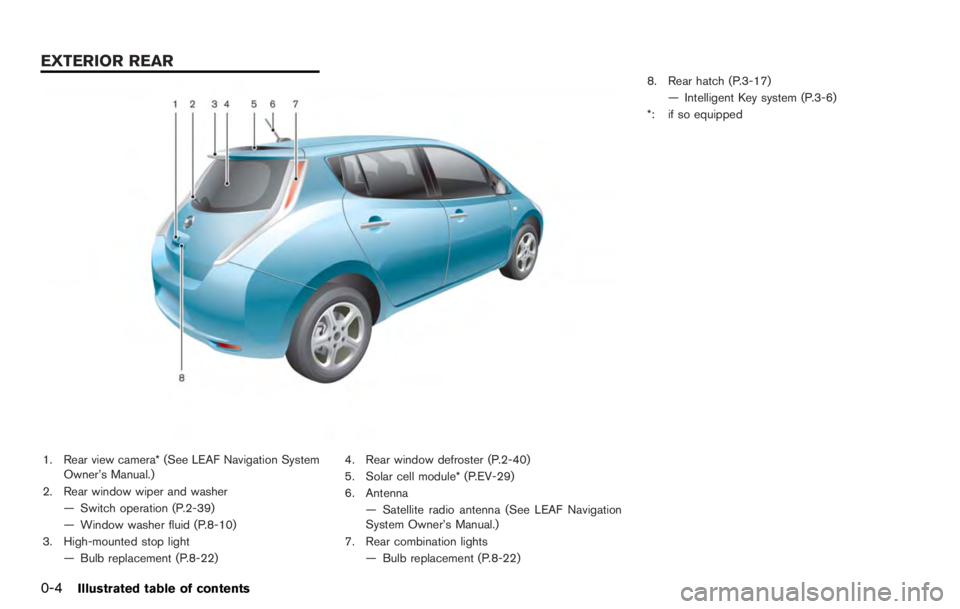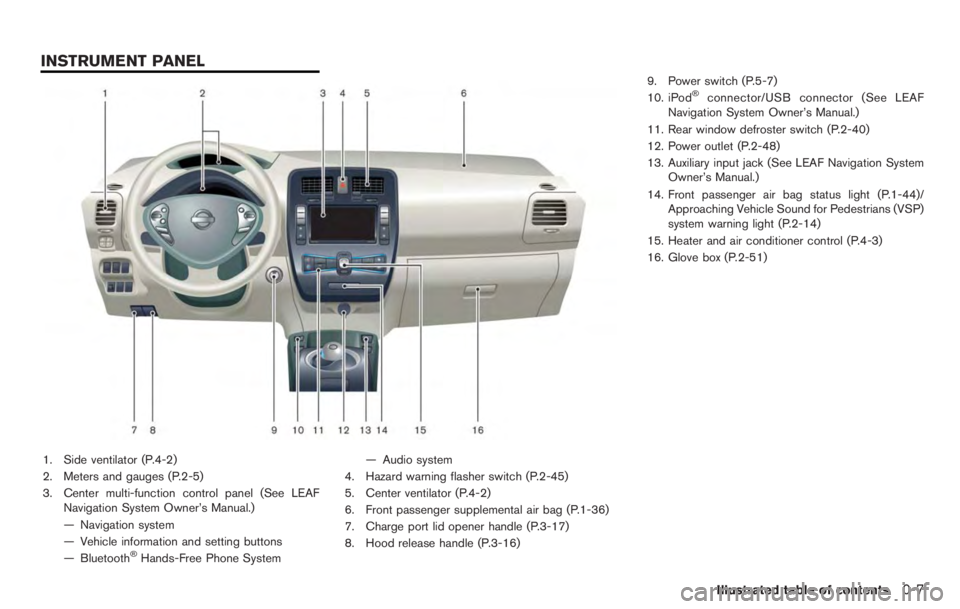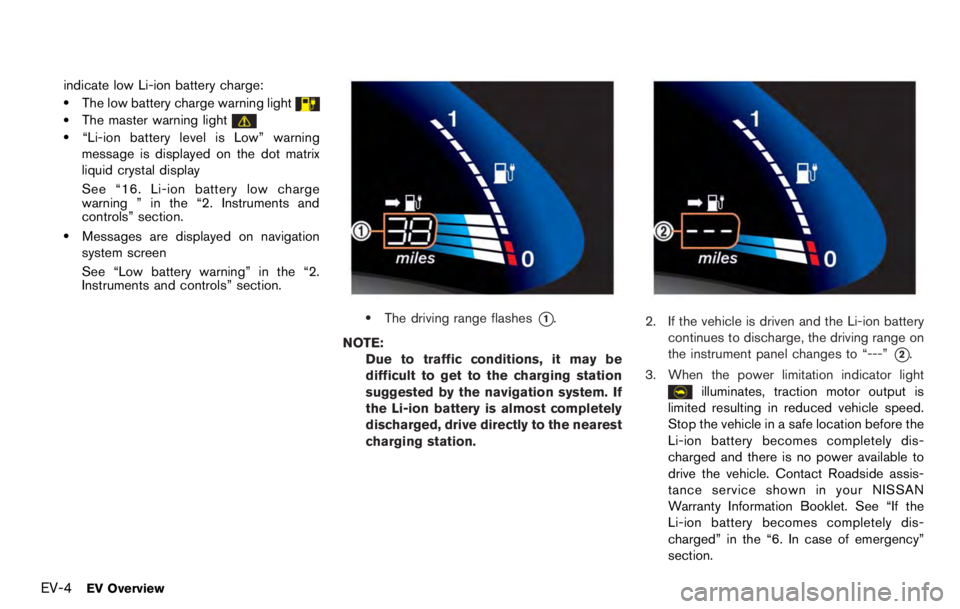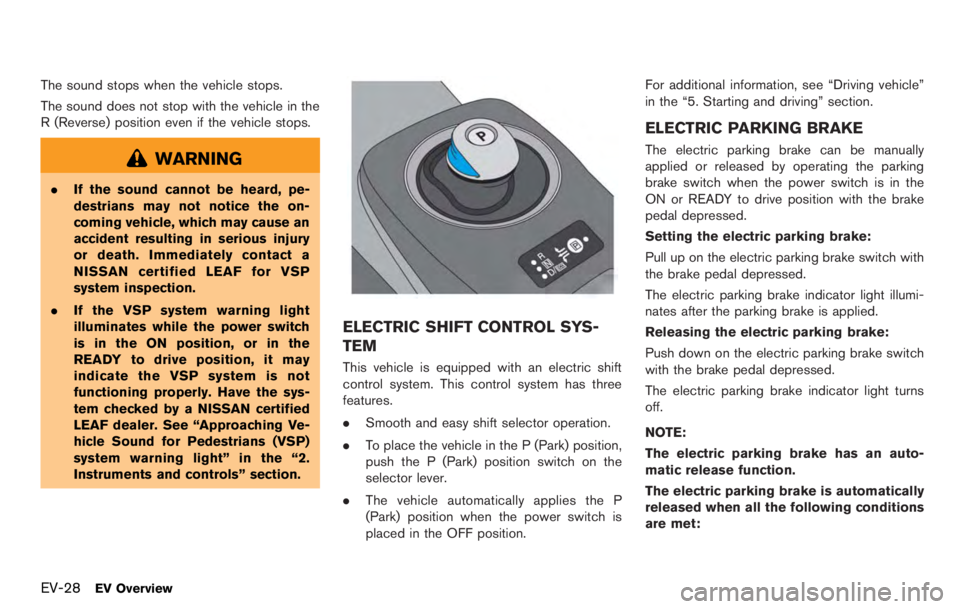2012 NISSAN LEAF tires
[x] Cancel search: tiresPage 1 of 1062

WARNING
.After using Emergency Tire Sealant
to repair a minor tire puncture, do
not drive the vehicle at speeds
faster than 50 MPH (80 km/h) .
. Immediately after using Emergency
Tire Sealant to repair a minor tire
puncture, take your vehicle to a
NISSAN certified LEAF dealer to
inspect, and repair or replace the
tire. The Emergency Tire Sealant
cannot permanently seal a punctu-
red tire. Continuing operation of the
vehicle without a permanent tire
repair can lead to a crash.
. Do not inject any tire liquid or
aerosol tire sealant into the tires,
as this may cause a malfunction of
the tire pressure sensors.
. If you used the Emergency Tire
Sealant to repair a minor tire punc-
ture, your NISSAN certified LEAF
dealer will also need to replace the
TPMS sensor in addition to repair-
ing or replacing the tire . .
NISSAN recommends using only
NISSAN Genuine Emergency Tire
Sealant provided with your vehicle.
Other tire sealants may damage the
valve stem seal which can cause the
tire to lose air pressure.
Page 8 of 1062

.Never tow a vehicle using the vehi-
cle tie down hook or recovery hook.
. Always pull the cable straight out
from the front of the vehicle. Never
pull on the vehicle at an angle.
. Pulling devices should be routed so
they do not touch any part of the
suspension, steering, brake or cool-
ing systems.
. Pulling devices such as ropes or
canvas straps are not recommended
for use in vehicle towing or recov-
ery.
Rocking a stuck vehicle
If the vehicle is stuck in sand, snow, mud, etc.,
try to free it by following the procedure below.
1. Turn off the Vehicle Dynamic Control (VDC)
system.
2. Make sure the area in front and behind the vehicle is clear of obstructions.
3. Turn the steering wheel left and right to clear an area around the front tires.
4. Slowly rock the vehicle forward and back- ward.
.Shift back and forth between the R
(Reverse) and D (Drive) positions.
.Apply the accelerator as little as possible
to maintain the rocking motion.
.Release the accelerator pedal before
shifting between R and D.
.Do not spin the tires above 35 MPH (55
km/h).
5. If the vehicle cannot be freed after a few tries, contact a professional towing service
to remove the vehicle.
Page 17 of 1062

pressure warning light. Use a tire pressure
gauge to check the tire pressure.
. The Check tire Pressure warning appears on
the dot matrix liquid crystal display when the
low tire pressure warning light is illuminated
and low tire pressure is detected. The
Check tire Pressure warning turns off when
the low tire pressure warning light turns off.
The Check tire Pressure warning does not
appear if the low tire pressure warning light
illuminates to indicate a TPMS malfunction.
. Tire pressure rises and falls depending on
the heat caused by operation of the vehicle
and the outside temperature. A low outside
temperature can decrease the temperature
of the air inside the tire, which can cause a
lower tire inflation pressure. This may cause
the low tire pressure warning light to
illuminate. If the warning light illuminates in
low ambient temperature, check the tire
pressure for all four tires.
For additional information, see “Low tire pres-
sure warning light” in the “2. Instruments and
controls” section and “Tire Pressure Monitoring
System (TPMS)” in the “6. In case of emer-
gency” section.
Page 18 of 1062

.Do not place metalized film or any
metal parts (antenna, etc.) on the
windows. This may cause poor re-
ception of the signals from the tire
pressure sensors, and the TPMS will
not function properly.
Some devices and transmitters may temporarily
interfere with the operation of the TPMS and
cause the low tire pressure warning light to
illuminate. Some examples are:
. Facilities or electric devices using similar
radio frequencies that are near the vehicle.
. If a transmitter set to similar frequencies is
being used in or near the vehicle.
. If a computer (or similar equipment) or a DC/
AC converter is being used in or near the
vehicle.
FCC Notice:
For USA:
This device complies with Part 15 of the
FCC Rules. Operation is subject to the
following two conditions: (1) This device
may not cause harmful interference, and
(2) this device must accept any interfer-
ence received, including interference that
may cause undesired operation. NOTE:
Changes or modifications not expressly
approved by the party responsible for
compliance could void the user’s authority
to operate the equipment.
For Canada:
This device complies with RSS-210 of
Industry Canada. Operation is subject to
the following two conditions: (1) this
device may not cause interference, and
(2) this device must accept any interfer-
ence, including interference that may
cause undesired operation of the device.
TPMS with Easy Fill Tire Alert
When tire pressure is low, the low tire pressure
warning light illuminates.
This vehicle provides visual and audible signals
to help you inflate the tires to the recommended
COLD tire pressure.
Vehicle set-up:
1. Park the vehicle in a safe and level place.
2. Apply the parking brake and push the P
position switch on the selector lever.
3. Place the power switch in the ON position. Do not place in the READY to drive mode. Operation:
1. Add air to the tire.
2. After a few seconds, the hazard indicators
will start flashing.
3. When the designated pressure is reached, the horn beeps once and the hazard
indicators stop flashing.
4. Perform the above steps for each tire.
. If the tire is over-inflated more than approxi-
mately 4 psi (30 kPa), the horn beeps and
the hazard indicators flash 3 times. To
correct the pressure, push the core of the
valve stem on the tire briefly to release
pressure. When the pressure reaches the
designated pressure, the horn beeps once.
. If the hazard indicator does not flash within
approximately 15 seconds after starting to
inflate the tire, it indicates that the Easy Fill
Tire Alert is not operating.
. The TPMS will not activate the Easy Fill Tire
Alert under the following conditions:
— If there is interference from an external
device or transmitter.
— The air pressure from the inflation device is not sufficient to inflate the tire such as
those using a power socket.
Page 20 of 1062

inflated tires.
Rapid air pressure loss can affect the handling
and stability of the vehicle, especially at highway
speeds.
Help prevent rapid air pressure loss by main-
taining the correct air pressure and visually
inspect the tires for wear and damage. See
“Wheels and tires” in the “8. Maintenance and
do-it-yourself” section of this manual.
If a tire rapidly loses air pressure or “blows-out”
while driving maintain control of the vehicle by
following the procedure below. Please note that
this procedure is only a general guide. The
vehicle must be driven as appropriate based on
the conditions of the vehicle, road and traffic.
Page 27 of 1062

Precautions on supplemental
restraint system..................................................... 1-36
Switch Autolight switch.................................................... 2-42
Fog light switch.................................................... 2-44
Hazard warning flasher switch.......................... 2-45
Headlight Aiming Control ................................. 2-44
Headlight switch................................................... 2-41
Power door lock switch......................................... 3-5
Rear window and outside mirror
defroster switch.................................................... 2-40
Turn signal switch ................................................ 2-44
Vehicle dynamic control (VDC) off switch..... 2-48
T
Telematics overview.................................................... 9-16
Temperature Li-ion battery temperature gauge........................ 2-7
Theft (NISSAN Vehicle Immobilizer System) ,
traction motor start ..................................................... 2-36
Tilt steering column .................................................... 3-19
Tire Low tire pressure warning light........................ 2-16
Tires Flat tire....................................................................... 6-2
Low tire pressure warning system...................... 5-2
Tire and Loading information label ......... 8-27, 9-8
Tire chains.............................................................. 8-31
Tire dressing............................................................. 7-4
Tire pressure ......................................................... 8-28
Tire pressure monitoring
system (TPMS) ............................................... 5-2, 6-2
Tire rotation............................................................ 8-32
Types of tires......................................................... 8-30
Uniform tire quality grading ............................... 9-14
Wheel/tire size......................................................... 9-5 Wheels and tires.................................................. 8-25
Tools............................................................................... 6-13
To p Tether strap child restraints............................... 1-22
Towing Flat towing ............................................................. 9-14
Tow truck towing.................................................. 6-13
Towing a trailer ..................................................... 9-13
TPMS, Tire pressure monitoring system................. 5-2
TPMS, Tire pressure warning system...................... 6-2
Traction motor Traction motor serial number ............................... 9-7
Trailer towing................................................................ 9-13
Transceiver, HomeLink
®Universal
Transceiver............................................................. 2-58
Transmitter, With Intelligent Key system
(See Intelligent Key system)..................................... 3-13
Trickle charge........................................................... CH-11
Trip computer............................................................... 2-27
Turn signal switch ....................................................... 2-44
Type of charge and how to charge the
Li-ion battery................................................................ CH-5
U
Underbody cleaning ..................................................... 7-3
Uniform tire quality grading ...................................... 9-14
Unplugged status.................................................... CH-25
V
Vanity mirror.................................................................. 3-22
Vehicle Dimensions and weights....................................... 9-5
Identification number (VIN)................................... 9-6
Loading information ............................................. 9-10
Recovery (freeing stuck vehicle) ...................... 6-15 Security system .................................................... 2-35
Vehicle dynamic control (VDC) off switch..... 2-48
Vehicle dynamic control (VDC) system.......... 5-24
Vehicle Dynamic Control (VDC)
warning light.......................................................... 2-19
Vehicle Dynamic Control (VDC) warning light .... 2-19
Vehicle security system ............................................. 2-35
Ventilators........................................................................ 4-2
W
Warning Hazard warning flasher switch.......................... 2-45
Indicators for operation....................................... 2-23
Tire pressure monitoring
system (TPMS) ............................................... 5-2, 6-2
Warning information displays............................ 2-31
Warning lights....................................................... 2-13
Warning/indicator lights and
audible reminders................................................. 2-12
Warning and indicator lights.................................... 0-10
Warning information displays................................... 2-31
Warning labels, Air bag warning labels................. 1-50
Warning light Air bag warning light................................ 1-50, 2-18
Anti-lock braking system (ABS)
warning light.......................................................... 2-14
BRAKE system warning light (yellow) ............ 2-14
BRAKE warning light (red) ................................ 2-15
Low tire pressure warning light........................ 2-16
Seat belt warning light........................................ 2-18
Vehicle Dynamic Control (VDC)
warning light.......................................................... 2-19
Washer switch Rear window wiper and washer switch ......... 2-39
Windshield wiper and washer switch............. 2-38
Washing........................................................................... 7-2
Index10-5
Page 51 of 1062

5.Three-digit code: Date of Manufacture
6.Four numbers represent the week and
year the tire was built. For example, the
numbers 3103 means the 31st week of
2003. If these numbers are missing,
then look on the other sidewall of the
tire.
*3Tire ply composition and material
The number of layers or plies of rubber-
coated fabric in the tire.
Tire manufacturers also must indicate
the materials in the tire, which include
steel, nylon, polyester, and others.
*4Maximum permissible inflation pressure
This number is the greatest amount of
air pressure that should be put in the
tire. Do not exceed the maximum
permissible inflation pressure.
*5Maximum load rating
This number indicates the maximum
load in kilograms and pounds that can
be carried by the tire. When replacing
the tires on the vehicle, always use a
tire that has the same load rating as the
factory installed tire.
*6Term of “tubeless” or “tube type”
Indicates whether the tire requires aninner tube (“tube type”) or not (“tube-
less”) .
*7The word “radial”
The word “radial” is shown, if the tire
has radial structure.
*8Manufacturer or brand name
Manufacturer or brand name is shown.
Other tire-related terminology:
In addition to the many terms that are
defined throughout this section, Intended
Outboard Sidewall is (1) the sidewall that
contains a whitewall, bears white lettering
or bears manufacturer, brand and/or model
name molding that is higher or deeper than
the same molding on the other sidewall of
the tire, or (2) the outward facing sidewall
of an asymmetrical tire that has a particular
side that must always face outward when
mounted on a vehicle.
TYPES OF TIRES
Page 53 of 1062

CHANGING WHEELS AND TIRES
Tire rotation
NISSAN recommends rotating the tires
every 7,500 miles (12,000 km) .
As soon as possible, tighten the wheel
nuts to the specified torque using a
torque wrench.
Wheel nut tightening torque:80 ft-lb (108 N·m)
The wheel nuts must be kept tigh-
tened to the specification at all times.
It is recommended that wheel nuts be
tightened to the specification at each
tire rotation interval.